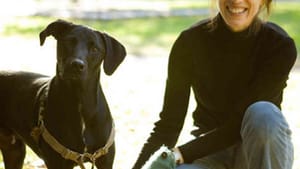Stay in the Loop
BSR publishes on a weekly schedule, with an email newsletter every Wednesday and Thursday morning. There’s no paywall, and subscribing is always free.
A walker in the city (who really opens her eyes)
‘On Looking,’ by Alexandra Horowitz

I am a walker and the daughter of a walker. At my father’s memorial service, someone who’d known him as a young man talked about his knowledge of the little streets that crisscross Center City, all of which he’d explored on foot. That memorial service was held at Haverford Friends Meeting, from which he and I sometimes walked home to Ardmore on a pleasant Sunday — one of my favorite childhood memories. It was less than two miles to our house, MapQuest tells me — a standard afternoon walk for me today, though it seemed like an ambitious trek when I was eight.
As an adult, I often find walking a practical matter, especially since I don’t own a car these days. It’s also one of my favorite — OK, only — forms of exercise. When I’m working, I’ll eat a sandwich at my desk, then take my “lunch” break in mid-afternoon, taking a half hour to do several laps around Rittenhouse Square if I’m in Center City, or trudge up and down the surprisingly steep hills of East Falls when I’m at home. It’s is a great way to clear your head and stretch your legs.
Inspired, perhaps, by walking Zen, I pride myself on being open to the environment as I walk. I’m unplugged from phone and iPod as I stroll or stride, and I try not to feel too superior to those who create their own little sonic microcosms as they move along.
Looking up
That said, however, it’s all too easy to forget, and to walk on the crowded sidewalks of Center City without actually seeing anything. I’m busy swerving around slow-moving pedestrians to avoid breaking my stride, ducking food carts and their queued customers, and evading oblivious texters as they weave on their unpredictable paths. Even when I’m walking for pleasure and not sprinting for a train or rushing into Cosi for an iced coffee on my way to meet a client, I’ve been known to stride right past a friend if I’m not expecting to encounter her. Oops!
Although I’m not Jewish, I celebrated Rosh Hashanah this year by making a new year’s resolution to be more mindful as I walk. Specifically, I resolved to look up at least once a day, to make a conscious effort to look above eye level. It turns out that it’s a very different way to experience the city.
You can see snippets of history both residential (the busybodies and insurance markers of Society Hill) and commercial (the Brooks Brothers sheep-in-a-sling logo above the main door of what is now a Staples at 15th and Chestnut; the restaurant across the street still bears the carved signage of a long-gone financial firm). Once-substantial buildings squat stubbornly next to new skyscraping neighbors (the Union League on South Broad, the Presbyterian church at 18th and Arch). Even those tall office buildings, if built long enough ago, sport carved and molded decorative elements above the modern facades that have been slapped on at street level.
Too many details
Since I’m at least as avid a reader as I am a walker, I was delighted to discover that the cognitive psychologist Alexandra Horowitz has given much thought to the issue of urban walking in her book, On Looking. She takes a series of typical city walks-around-the-block, the first on her own, to set a baseline, and then a dozen more, one at a time with 11 experts in various fields, to see what they see.
Her first companion, however, is her toddler son, who sees the world with a freshness that no adult can fully master. “Part of normal human development is learning to notice less than we are able to,” she writes. “The world is awash in details of color, form, sound — but to function, we have to ignore some of it. The world still holds these details. Children sense the world at a different granularity, attending to parts of the visual world we gloss over; to sounds we have dismissed as irrelevant. What is indiscernible to us is plain to them.”
The underlying issues of perception and cognition form their own track through her book, and they’re illuminated through her walks (and conversations) with the 11 experts. Horowitz divides these into three main groups: the first section of the book is the city as an inanimate object, as observed by a geologist, a typographer, and an artist. The city is also filled with living beings, so she then walks with a field naturalist (with whom she looks at bugs) and a wildlife scientist (with whom she looks at larger critters). Humans, of course, are the most visible inhabitants, so she also walks with an urban sociologist and a physician.
The trouble with expectations
In the book’s final section, Horowitz walks with those whose sensory experience is less reliant on sight than most of us are: a blind woman, a sound designer, and a dog, whose universe of scent-perceptions is perhaps the closest we can come to traveling with an alien.
Horowitz seamlessly combines information about what she experiences through the guidance of her companions with discussions about perception and lack of perception: “We have an expectation about what we will see, and we are actually perceptually restricted by that expectation,” she writes. “In a sense, expectation is the lost cousin of attention: Both serve to reduce what we need to process of the world ‘out there’.”
On Looking encourages us all to look anew — to reflect on both what we see and why we see it the way we do. Do you observe the world as one of Horowitz’s experts does, or in some other way entirely?
What, When, Where
On Looking: Eleven Walks with Expert Eyes. By Alexandra Horowitz. Scribner, 2013. 320 pages; $21.60. books.simonandschuster.com.
Sign up for our newsletter
All of the week's new articles, all in one place. Sign up for the free weekly BSR newsletters, and don't miss a conversation.

 Judy Weightman
Judy Weightman